Arbel Cliff
Facing south: To the right of nearby Upper Tiberias (the water tower), we can see the top of the perfectly rounded Mt. Tabor. Just west of it is the Nazareth ridge, which belonged to the Israelite tribe of Zebulon. We, for our part, are standing in Naftali. And so we have around us all the ingredients of Matthew 4: 12 - 20.
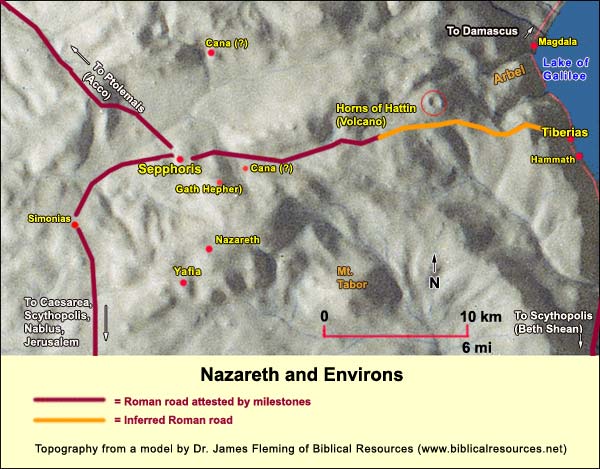
The eastern side of the lake makes up part of the Golan Heights. Here we can locate Kursi, the ancient Gergesa. (In Matthew 8:28, Gergesa is the place where Jesus cast demons into swine.) Above Kibbutz Ein Gev one can discern the acropolis of Hippos (a.k.a. Sussita), a city of the Decapolis.A league of cities under Roman auspices. Sometimes ten are mentioned, sometimes more. They included Damascus (an honorary member), Hippos, Gadera, Gerasa (Jerash), Pella, Scythopolis and Philadelphia (Amman). Other cities were later added to the original ten. In the first century AD, however, no coins minted in these cities mention a Decapolis. Matthew (4:25) and Mark (5:20, 7:31) write of Jesus' passing through it. All other historical references to the league date from after the outbreak of the Jewish revolt in 66 AD. (See Rainey and Notley, The Sacred Bridge, Jerusalem: Carta, 2006, pp. 361-362)
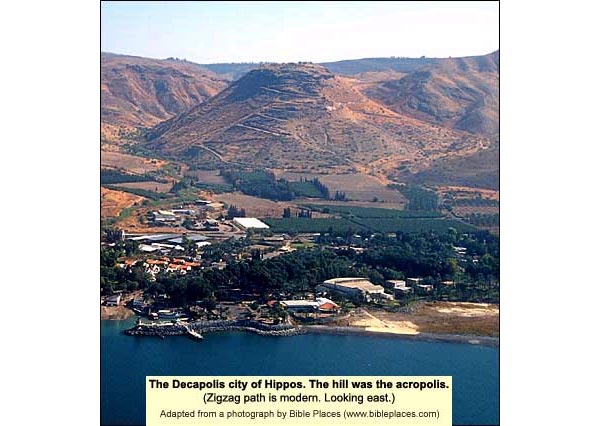
Looking north again, this time to the mountains of Upper Galilee, we see Safed (Tzfat), at 2800 feet the highest city in the State of Israel, famous as the home of Jewish mysticism in the 16th century.
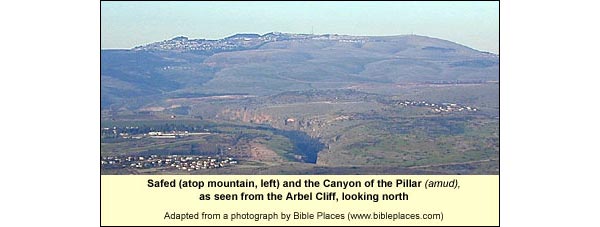
Backtracking on the path, we can spot many caves in the cliff across the way, called Mount Nittai. There are also cliffs below us in the Arbel (enlarge picture, right). A piece of history is connected with them, told by Josephus in War,Josephus Flavius, The Jewish War, translated by William Whiston Book I, 16.2: But when Herod had reached Sepphoris, in a very great snow, he took the city without any difficulty; the guards that should have kept it flying away before it was assaulted; where he gave an opportunity to his followers that had been in distress to refresh themselves, there being in that city a great abundance of necessaries. After which he hasted away to the robbers that were in the caves, who overran a great part of the country, and did as great mischief to its inhabitants as a war itself could have done. Accordingly, he sent beforehand three cohorts of footmen, and one troop of horsemen, to the village Arbela, and came himself forty days afterwards with the rest of his forces.... But Herod followed them, and slew them as he followed them, and destroyed a great part of them, till those that remained were scattered beyond the river; and Galilee was freed from the terrors they had been under, excepting from those that remained, and lay concealed in caves, which required longer time ere they could be conquered... In the mean time Antony abode at Athens, while Ventidius called for Silo and Herod to come to the war against the Parthians, but ordered them first to settle the affairs of Judea; so Herod willingly dismissed Silo to go to Ventidius, but he made an expedition himself against those that lay in the caves. Now these caves were in the precipices of craggy mountains, and could not be come at from any side, since they had only some winding pathways, very narrow, by which they got up to them; but the rock that lay on their front had beneath it valleys of a vast depth, and of an almost perpendicular declivity; insomuch that the king was doubtful for a long time what to do, by reason of a kind of impossibility there was of attacking the place. Yet did he at length make use of a contrivance that was subject to the utmost hazard; for he let down the most hardy of his men in chests, and set them at the mouths of the dens. Now these men slew the robbers and their families, and when they made resistance, they sent in fire upon them; and as Herod was desirous of saving some of them, he had proclamation made, that they should come and deliver themselves up to him; but not one of them came willingly to him; and of those that were compelled to come, many preferred death to captivity. And here a certain old man, the father of seven children, whose children, together with their mother, desired him to give them leave to go out, upon the assurance and right hand that was offered them, slew them after the following manner: He ordered every one of them to go out, while he stood himself at the cave's mouth, and slew that son of his perpetually who went out. Herod was near enough to see this sight, and his bowels of compassion were moved at it, and he stretched out his right hand to the old man, and besought him to spare his children; yet did not he relent at all upon what he said, but over and above reproached Herod on the lowness of his descent, and slew his wife as well as his children; and when he had thrown their dead bodies down the precipice, he at last threw himself down after them. Just west of MoshavMoshav Ovdim: a form of agricultural community based on the lease of government land. Each member receives an income according to what he or she produces on the land allotted, but the members do much of their buying and selling together as a group. Moshav Shitufi: a form of agricultural community combining features of the Moshav Ovdim with those of the Kibbutz: the entire enterprise is held in common, services are also provided in common, but consumption is on a family-basis, depending on family size and the number of days its members work Arbel, there is a partial restoration of an ancient synagogue from the 4th (?) until the 8th centuries AD. For Arbela was a Jewish town in the Roman period.
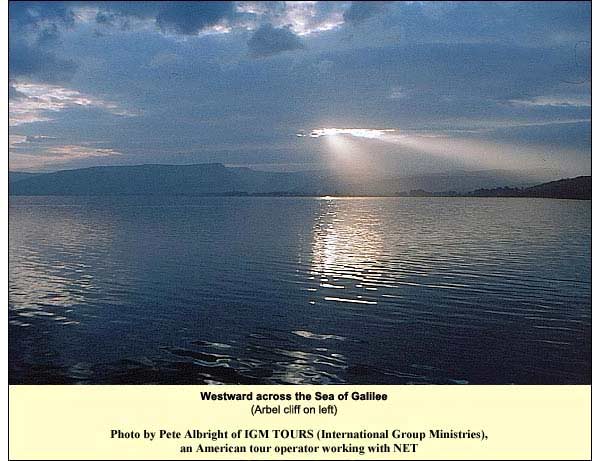
{mospagebreak title=Hike} Hiking the Arbel cliff The Arbel also offers a hike. It can include a descent of the cliff, using cables and metal rungs hammered into the rock. (This really adventurous part takes most people about fifteen or twenty minutes.) The descent follows a zigzag path to Wadi Hamam, the Valley of the Doves, so called because the wind, playing through the many caves in the cliff face, can make a sound like cooing. In this valley was a well-to-do Jewish village in the Roman and Byzantine periods. The mosaic floor of its synagogue was discovered in 2007. It features, uniquely, images of woodworkers building a structure, perhaps the Temple or Noah's ark. The mosaic is presently undergoing preservation and is not yet visible on site. (More on this discovery, with a picture...) Here is a series of images showing what the hike is like. In order to have time for the view, a Bible reading, meditation and descent, one should leave at least two and a half hours. The bus waits in Wadi Hamam. It is possible to omit the descent, walk along the cliff edge for ten minutes (first picture below) and then cut back to the bus before it leaves for Wadi Hamam.
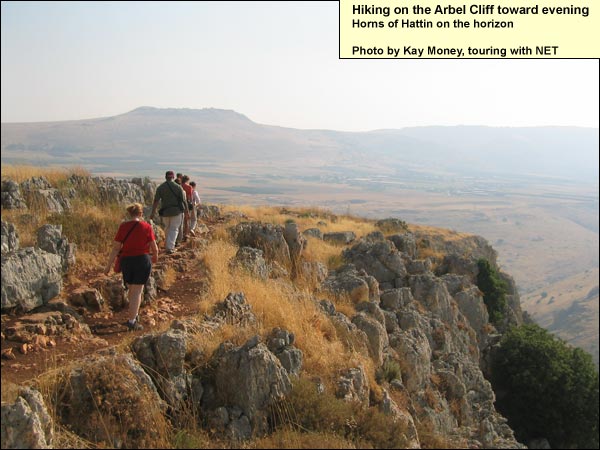
{mospagebreak title=Logistics} Logistics for the Arbel cliff As of July 1, 2008 the Arbel cliff is a National Park and Nature Reserve. An entrance fee is charged, and there are rest rooms. Opening hours: April 1 through September 30, from 8.00 - 17.00. (Entrance until 16.00)* October 1 through March 31, from 8.00 - 16.00. (Entrance until 15.00)* *On Fridays and the eves of Jewish holidays, the sites close one hour earlier. For example, on a Friday in March one must enter by 14.00 and leave by 15.00. If you arrive too close to the last time for entrance, the person in the booth may permit only the view and not the descent of the cliff. Phone at the site: 04-6732904. In order to make an exception to the above opening hours, one should consult in advance with the manager of the site.

The eastern side of the lake makes up part of the Golan Heights. Here we can locate Kursi, the ancient Gergesa. (In Matthew 8:28, Gergesa is the place where Jesus cast demons into swine.) Above Kibbutz Ein Gev one can discern the acropolis of Hippos (a.k.a. Sussita), a city of the Decapolis.A league of cities under Roman auspices. Sometimes ten are mentioned, sometimes more. They included Damascus (an honorary member), Hippos, Gadera, Gerasa (Jerash), Pella, Scythopolis and Philadelphia (Amman). Other cities were later added to the original ten. In the first century AD, however, no coins minted in these cities mention a Decapolis. Matthew (4:25) and Mark (5:20, 7:31) write of Jesus' passing through it. All other historical references to the league date from after the outbreak of the Jewish revolt in 66 AD. (See Rainey and Notley, The Sacred Bridge, Jerusalem: Carta, 2006, pp. 361-362)

Looking north again, this time to the mountains of Upper Galilee, we see Safed (Tzfat), at 2800 feet the highest city in the State of Israel, famous as the home of Jewish mysticism in the 16th century.

Backtracking on the path, we can spot many caves in the cliff across the way, called Mount Nittai. There are also cliffs below us in the Arbel (enlarge picture, right). A piece of history is connected with them, told by Josephus in War,Josephus Flavius, The Jewish War, translated by William Whiston Book I, 16.2: But when Herod had reached Sepphoris, in a very great snow, he took the city without any difficulty; the guards that should have kept it flying away before it was assaulted; where he gave an opportunity to his followers that had been in distress to refresh themselves, there being in that city a great abundance of necessaries. After which he hasted away to the robbers that were in the caves, who overran a great part of the country, and did as great mischief to its inhabitants as a war itself could have done. Accordingly, he sent beforehand three cohorts of footmen, and one troop of horsemen, to the village Arbela, and came himself forty days afterwards with the rest of his forces.... But Herod followed them, and slew them as he followed them, and destroyed a great part of them, till those that remained were scattered beyond the river; and Galilee was freed from the terrors they had been under, excepting from those that remained, and lay concealed in caves, which required longer time ere they could be conquered... In the mean time Antony abode at Athens, while Ventidius called for Silo and Herod to come to the war against the Parthians, but ordered them first to settle the affairs of Judea; so Herod willingly dismissed Silo to go to Ventidius, but he made an expedition himself against those that lay in the caves. Now these caves were in the precipices of craggy mountains, and could not be come at from any side, since they had only some winding pathways, very narrow, by which they got up to them; but the rock that lay on their front had beneath it valleys of a vast depth, and of an almost perpendicular declivity; insomuch that the king was doubtful for a long time what to do, by reason of a kind of impossibility there was of attacking the place. Yet did he at length make use of a contrivance that was subject to the utmost hazard; for he let down the most hardy of his men in chests, and set them at the mouths of the dens. Now these men slew the robbers and their families, and when they made resistance, they sent in fire upon them; and as Herod was desirous of saving some of them, he had proclamation made, that they should come and deliver themselves up to him; but not one of them came willingly to him; and of those that were compelled to come, many preferred death to captivity. And here a certain old man, the father of seven children, whose children, together with their mother, desired him to give them leave to go out, upon the assurance and right hand that was offered them, slew them after the following manner: He ordered every one of them to go out, while he stood himself at the cave's mouth, and slew that son of his perpetually who went out. Herod was near enough to see this sight, and his bowels of compassion were moved at it, and he stretched out his right hand to the old man, and besought him to spare his children; yet did not he relent at all upon what he said, but over and above reproached Herod on the lowness of his descent, and slew his wife as well as his children; and when he had thrown their dead bodies down the precipice, he at last threw himself down after them. Just west of MoshavMoshav Ovdim: a form of agricultural community based on the lease of government land. Each member receives an income according to what he or she produces on the land allotted, but the members do much of their buying and selling together as a group. Moshav Shitufi: a form of agricultural community combining features of the Moshav Ovdim with those of the Kibbutz: the entire enterprise is held in common, services are also provided in common, but consumption is on a family-basis, depending on family size and the number of days its members work Arbel, there is a partial restoration of an ancient synagogue from the 4th (?) until the 8th centuries AD. For Arbela was a Jewish town in the Roman period.

{mospagebreak title=Hike} Hiking the Arbel cliff The Arbel also offers a hike. It can include a descent of the cliff, using cables and metal rungs hammered into the rock. (This really adventurous part takes most people about fifteen or twenty minutes.) The descent follows a zigzag path to Wadi Hamam, the Valley of the Doves, so called because the wind, playing through the many caves in the cliff face, can make a sound like cooing. In this valley was a well-to-do Jewish village in the Roman and Byzantine periods. The mosaic floor of its synagogue was discovered in 2007. It features, uniquely, images of woodworkers building a structure, perhaps the Temple or Noah's ark. The mosaic is presently undergoing preservation and is not yet visible on site. (More on this discovery, with a picture...) Here is a series of images showing what the hike is like. In order to have time for the view, a Bible reading, meditation and descent, one should leave at least two and a half hours. The bus waits in Wadi Hamam. It is possible to omit the descent, walk along the cliff edge for ten minutes (first picture below) and then cut back to the bus before it leaves for Wadi Hamam.

{mospagebreak title=Logistics} Logistics for the Arbel cliff As of July 1, 2008 the Arbel cliff is a National Park and Nature Reserve. An entrance fee is charged, and there are rest rooms. Opening hours: April 1 through September 30, from 8.00 - 17.00. (Entrance until 16.00)* October 1 through March 31, from 8.00 - 16.00. (Entrance until 15.00)* *On Fridays and the eves of Jewish holidays, the sites close one hour earlier. For example, on a Friday in March one must enter by 14.00 and leave by 15.00. If you arrive too close to the last time for entrance, the person in the booth may permit only the view and not the descent of the cliff. Phone at the site: 04-6732904. In order to make an exception to the above opening hours, one should consult in advance with the manager of the site.